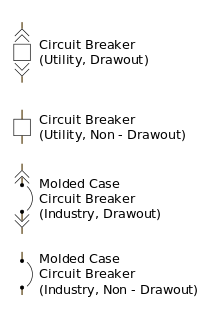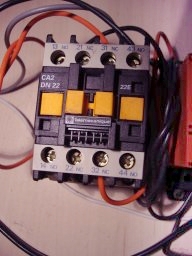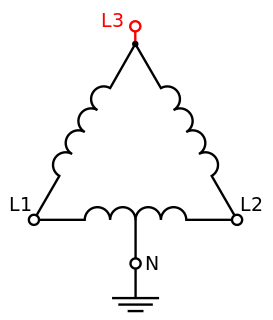
Three-phase electric power is a common method of alternating current electric power generation, transmission, and distribution. It is a type of polyphase system and is the most common method used by electrical grids worldwide to transfer power. It is also used to power large motors and other heavy loads.
In electrical engineering, the power factor of an AC electrical power system is defined as the ratio of the real power absorbed by the load to the apparent power flowing in the circuit, and is a dimensionless number in the closed interval of −1 to 1. A power factor of less than one indicates the voltage and current are not in phase, reducing the instantaneous product of the two. Real power is the instantaneous product of voltage and current and represents the capacity of the electricity for performing work. Apparent power is the average product of current and voltage. Due to energy stored in the load and returned to the source, or due to a non-linear load that distorts the wave shape of the current drawn from the source, the apparent power may be greater than the real power. A negative power factor occurs when the device generates power, which then flows back towards the source.

A circuit breaker is an automatically operated electrical switch designed to protect an electrical circuit from damage caused by excess current from an overload or short circuit. Its basic function is to interrupt current flow after a fault is detected. Unlike a fuse, which operates once and then must be replaced, a circuit breaker can be reset to resume normal operation.
Electrical wiring in North America follows regulations and standards for installation of building wiring which ultimately provides mains electricity.

The input impedance of an electrical network is the measure of the opposition to current (impedance), both static (resistance) and dynamic (reactance), into the load network that is external to the electrical source. The input admittance (1/impedance) is a measure of the load's propensity to draw current. The source network is the portion of the network that transmits power, and the load network is the portion of the network that consumes power.

In electronics and electrical engineering, a fuse is an electrical safety device that operates to provide overcurrent protection of an electrical circuit. Its essential component is a metal wire or strip that melts when too much current flows through it, thereby interrupting the current. It is a sacrificial device; once a fuse has operated it is an open circuit, and it must be replaced or rewired, depending on type.

A solar inverter or PV inverter, is a type of electrical converter which converts the variable direct current (DC) output of a photovoltaic (PV) solar panel into a utility frequency alternating current (AC) that can be fed into a commercial electrical grid or used by a local, off-grid electrical network. It is a critical balance of system (BOS)–component in a photovoltaic system, allowing the use of ordinary AC-powered equipment. Solar power inverters have special functions adapted for use with photovoltaic arrays, including maximum power point tracking and anti-islanding protection.

An arc-fault circuit interrupter (AFCI) also known as an arc-fault detection device (AFDD) is a circuit breaker that breaks the circuit when it detects an electric arc in the circuit it protects to prevent electrical fires. An AFCI selectively distinguishes between a harmless arc, and a potentially dangerous arc.

A split-phase or single-phase three-wire system is a type of single-phase electric power distribution. It is the AC equivalent of the original Edison three-wire direct-current system. Its primary advantage is that it saves conductor material over a single-ended single-phase system, while only requiring a single phase on the supply side of the distribution transformer.
As the neutral point of an electrical supply system is often connected to earth ground, ground and neutral are closely related. Under certain conditions, a conductor used to connect to a system neutral is also used for grounding (earthing) of equipment and structures. Current carried on a grounding conductor can result in objectionable or dangerous voltages appearing on equipment enclosures, so the installation of grounding conductors and neutral conductors is carefully defined in electrical regulations. Where a neutral conductor is used also to connect equipment enclosures to earth, care must be taken that the neutral conductor never rises to a high voltage with respect to local ground.
A traction motor is an electric motor used for propulsion of a vehicle, such as an electric locomotive or electric roadway vehicle.

Electrical wiring is an electrical installation of cabling and associated devices such as switches, distribution boards, sockets and light fittings in a structure.
Electrical wiring in the United Kingdom is commonly understood to be an electrical installation for operation by end users within domestic, commercial, industrial, and other buildings, and also in special installations and locations, such as marinas or caravan parks. It does not normally cover the transmission of electrical power to them.

A volt-ampere (VA) is the unit used for the apparent power in an electrical circuit, equal to the product of root-mean-square (RMS) voltage and RMS current. In direct current (DC) circuits, this product is equal to the real power in watts. Volt-amperes are useful only in the context of alternating current (AC) circuits.
Voltage drop describes how the energy supplied by a voltage source is reduced as electric current moves through the passive elements of an electrical circuit. The voltage drop across the internal resistance of the source, across conductors, across contacts, and across connectors is undesirable because some of the energy supplied is lost (dissipated). The voltage drop across the electrical load and across other active circuit elements is essential for supply of energy and so is not undesirable.

A contactor is an electrically-controlled switch used for switching an electrical power circuit. A contactor is typically controlled by a circuit, which has a much lower power level than the switched circuit, such as a 24-volt coil electromagnet controlling a 230-volt motor switch.

High-leg delta is a type of electrical service connection for three-phase electric power installations. It is used when both single and three-phase power is desired to be supplied from a three phase transformer. The three-phase power is connected in the delta configuration, and the center point of one phase is grounded. This creates both a split-phase single phase supply and three-phase. It is called "orange leg" because the wire is color-coded orange. By convention, the high leg is usually set in the center lug in the involved panel, regardless of the L1-L2-L3 designation at the transformer.

A grid-tie inverter converts direct current (DC) into an alternating current (AC) suitable for injecting into an electrical power grid, normally 120 V RMS at 60 Hz or 240 V RMS at 50 Hz. Grid-tie inverters are used between local electrical power generators: solar panel, wind turbine, hydro-electric, and the grid.
In building wiring, multiway switching is the interconnection of two or more electrical switches to control an electrical load from more than one location. For example, this allows lighting in a hallway, stairwell or large room to be controlled from multiple locations. While a "normal" light switch needs to be only a single pole, single throw (SPST) switch, multiway switching requires the use of switches that have one or more additional contacts and two or more wires must be run between the switches. When the load is controlled from only two points, single pole, double throw (SPDT) switches are used. Double pole, double throw (DPDT) switches allow control from three or more locations.













